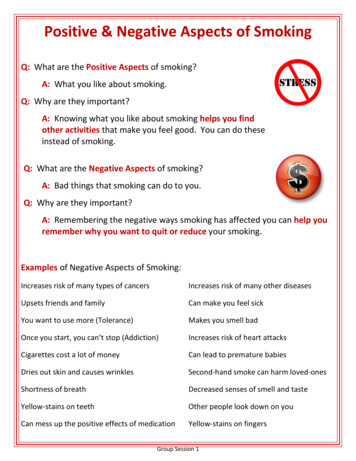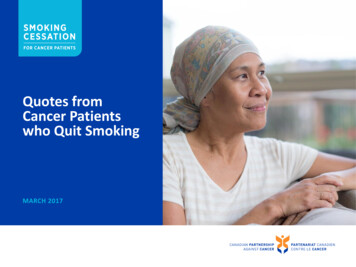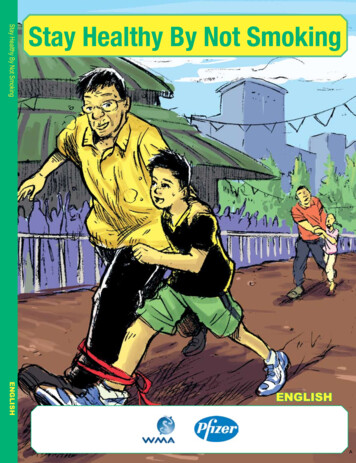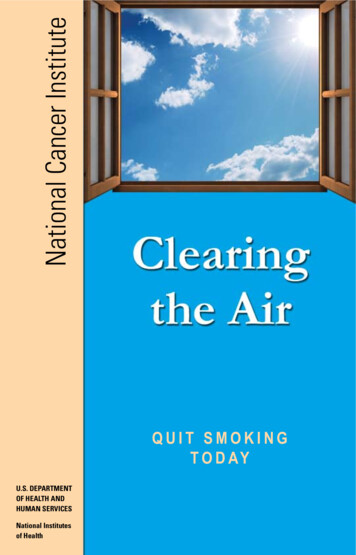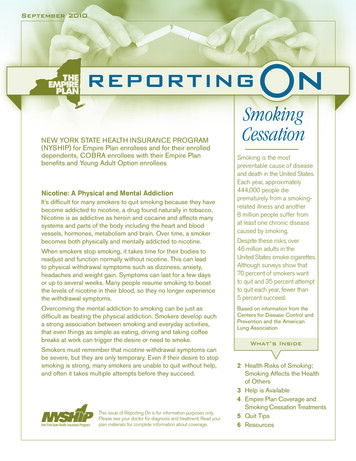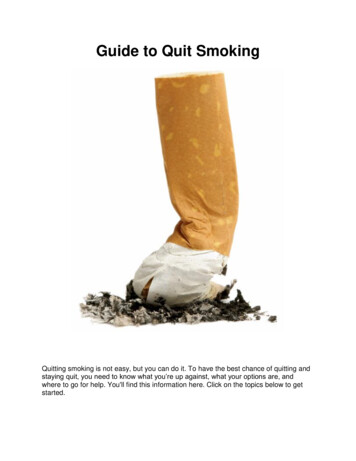
Transcription
Guide to Quit SmokingQuitting smoking is not easy, but you can do it. To have the best chance of quitting andstaying quit, you need to know what you’re up against, what your options are, andwhere to go for help. You'll find this information here. Click on the topics below to getstarted.
1. What do I need to know about quitting?What do I need to know about quitting?The US Surgeon General has said, "Smoking cessation (stopping smoking) representsthe single most important step that smokers can take to enhance the length and qualityof their lives."Quitting smoking is not easy, but you can do it. To have the best chance of quitting andstaying quit, you need to know what you’re up against, what your options are, andwhere to go for help. You'll find this information here.Why is it so hard to quit smoking?Mark Twain said, "Quitting smoking is easy. I've done it a thousand times." Maybeyou've tried to quit, too. Why is quitting and staying quit hard for so many people? Theanswer is nicotine.NicotineNicotine is a drug found naturally in tobacco. It is as addictive as heroin or cocaine.Over time, a person becomes physically and emotionally addicted to (dependent on)nicotine. Studies have shown that smokers must deal with both the physical andpsychological (mental) dependence to quit and stay quit.How nicotine gets in, where it goes, and how long it stays?When you inhale smoke, nicotine is carried deep into your lungs. There it is quicklyabsorbed into the bloodstream and carried throughout your body. Nicotine affects manyparts of the body, including your heart and blood vessels, your hormones, the way yourbody uses food (your metabolism), and your brain. Nicotine can be found in breast milkand even in mucus from the cervix of a female smoker. During pregnancy, nicotinefreely crosses the placenta and has been found in amniotic fluid and the umbilical cordblood of newborn infants.Different factors affect how long it takes the body to remove nicotine and its byproducts. In most cases, regular smokers will still have nicotine or its by-products, suchas cotinine, in their bodies for about 3 to 4 days after stopping.
How nicotine hooks smokers?Nicotine causes pleasant feelings that make the smoker want to smoke more. It alsoacts as a kind of depressant by interfering with the flow of information between nervecells. Smokers tend to increase the number of cigarettes they smoke as the nervoussystem adapts to nicotine. This, in turn, increases the amount of nicotine in the smoker'sblood. In fact, nicotine inhaled in cigarette smoke reaches the brain faster than drugsthat enter the body through a vein (intravenously or IV).After a while, the smoker develops a tolerance to the drug. Tolerance means that ittakes more nicotine to get the same effect that the smoker used to get from smalleramounts. This leads to an increase in smoking over time. The smoker reaches a certainnicotine level and then keeps smoking to maintain this level of nicotine.Nicotine withdrawal symptoms can lead quitters back to smokingWhen smokers try to cut back or quit, the lack of nicotine leads to withdrawal symptoms.Withdrawal is both physical and mental. Physically, the body reacts to the absence ofnicotine. Mentally, the smoker is faced with giving up a habit, which calls for a majorchange in behavior. Both the physical and mental factors must be addressed for thequitting process to work.Those who have smoked regularly for a few weeks or longer, and suddenly stop usingtobacco or greatly reduce the amount smoked, will have withdrawal symptoms.Symptoms usually start within a few hours of the last cigarette and peak about 2 to 3days later when most of the nicotine and its by-products are out of the body. Withdrawalsymptoms can last for a few days to up to several weeks. They will get better every daythat you stay smoke-free.Withdrawal symptoms can include any of the following: Dizziness (which may only last 1 to 2 days after quitting) Depression Feelings of frustration, impatience, and anger Anxiety Irritability Sleep disturbances, including having trouble falling asleep and staying asleep, andhaving bad dreams or even nightmares
Trouble concentrating Restlessness or boredom Headaches Tiredness Increased appetite Weight gain Constipation and gas Cough, dry mouth, sore throat, and nasal drip Chest tightnessThese symptoms can lead the smoker to start smoking cigarettes again to boost bloodlevels of nicotine back to a level where there are no symptoms. (For information oncoping with withdrawal, see the section, "How to quit.")Smoking also makes your body get rid of some drugs faster than usual. When you quitsmoking, it may change the way your body handles medicines. Ask your doctor if anymedicines you take regularly need to be checked or changed after you quit.
2. Why should I quit?Your HealthHealth concerns usually top the list of reasons people give for quitting smoking. This isa very real concern: Half of all smokers who keep smoking will end up dying from asmoking-related illness. In the US alone, smoking is responsible for nearly 1 in 5deaths, and about 8.6 million people suffer from smoking-related lung and heartdiseases.CancerNearly everyone knows that smoking can cause lung cancer, but few people realize it isalso a risk factor for many other kinds of cancer too, including cancer of the mouth,voice box (larynx), throat (pharynx), esophagus, bladder, kidney, pancreas, cervix,stomach, and some leukemias.Lung diseasesPneumonia is included in the list of diseases known to be caused by smoking. Smokingalso increases your risk of getting lung diseases like emphysema and chronicbronchitis. These diseases are grouped together under the term COPD (chronicobstructive pulmonary disease). COPD causes on-going (chronic) illness and disability,and worsens over time -- sometimes becoming fatal. Emphysema and chronicbronchitis can be found in people as young as 40, but are usually found later in life,when the symptoms get much worse. Long-term smokers have the highest risk ofdeveloping severe COPD.Heart attacks, strokes, and blood vessel diseasesSmokers are twice as likely to die from heart attacks as are non-smokers. And smokingis a major risk factor for peripheral vascular disease, a narrowing of the blood vesselsthat carry blood to the leg and arm muscles. Smoking also affects the walls of thevessels that carry blood to the brain (carotid arteries), which can cause strokes. Menwho smoke are more likely to develop erectile dysfunction (impotence) because ofblood vessel disease.Blindness and other problemsSmoking causes an increased risk of macular degeneration, one of the most commoncauses of blindness in older people. It also causes premature wrinkling of the skin, badbreath, gum and tooth problems, bad-smelling clothes and hair, yellow fingernails.
Special risks to women and babiesWomen have some unique risks linked to smoking. Women over 35 who smoke anduse birth control pills have a higher risk of heart attack, stroke, and blood clots of thelegs. Women who smoke are more likely to miscarry (lose the baby) or have a lowerbirth-weight baby. And low birth-weight babies are more likely to die, or have learningand physical problems.Years of life lost due to smokingBased on data collected in the late 1990s, the US Centers for Disease Control andPrevention (CDC) estimated that adult male smokers lost an average of 13.2 years oflife and female smokers lost 14.5 years of life because of smoking. And given thediseases that smoking can cause, it can steal your quality of life long before you die.Smoking-related illness can limit your activities by making it harder to breathe, getaround, work, or play.Why quit now?No matter how old you are or how long you've smoked, quitting can help you live longerand be healthier. People who stop smoking before age 50 cut their risk of dying in thenext 15 years in half compared with those who keep smoking. Ex-smokers enjoy ahigher quality of life with fewer illnesses from cold and flu viruses, better self-reportedhealth, and reduced rates of bronchitis and pneumonia.For decades the Surgeon General has reported the health risks linked to smoking. In1990, the Surgeon General concluded: Quittingsmoking has major and immediate health benefits for men and women ofall ages. These benefits apply to people who already have smoking-relateddisease and those who don't. Ex-smokerslive longer than people who keep smoking. Quittingsmoking lowers the risk of lung cancer, other cancers, heart attack,stroke, and chronic lung disease. Womenwho stop smoking before pregnancy or during the first 3 to 4 months ofpregnancy reduce their risk of having a low birth-weight baby to that of womenwho never smoked. Thehealth benefits of quitting smoking are far greater than any risks from thesmall weight gain (usually less than 10 pounds) or any emotional orpsychological problems that may follow quitting.
3. When smokers quit -- What are thebenefits over time?20 minutes after quitting: Your heart rate and blood pressure drops.(Mahmud A, Feely J. Effect of Smoking on Arterial Stiffness and Pulse PressureAmplification. Hypertension. 2003;41:183.)12 hours after quitting: The carbon monoxide level in your blood drops to normal.(US Surgeon General's Report, 1988, p. 202)2 weeks to 3 months after quitting: Your circulation improves and your lung functionincreases.(US Surgeon General's Report, 1990, pp. 193, 194, 196, 285, 323)1 to 9 months after quitting: Coughing and shortness of breath decrease; cilia (tinyhair-like structures that move mucus out of the lungs) regain normal function in thelungs, increasing the ability to handle mucus, clean the lungs, and reduce the risk ofinfection.(US Surgeon General's Report, 1990, pp. 285-287, 304)1 year after quitting: The excess risk of coronary heart disease is half that of asmoker's.(US Surgeon General's Report, 1990, p. vi)5 years after quitting: Your stroke risk is reduced to that of a non-smoker 5 to 15 yearsafter quitting.(US Surgeon General's Report, 1990, p. vi)10 years after quitting: The lung cancer death rate is about half that of a person whocontinues smoking. The risk of cancer of the mouth, throat, esophagus, bladder, cervix,and pancreas decrease, too.(US Surgeon General's Report, 1990, pp. vi, 131, 148, 152, 155, 164, 166)15 years after quitting: The risk of coronary heart disease is the same as a nonsmoker's.(US Surgeon General's Report, 1990, p. vi)
4. Immediate rewards of quittingKicking the tobacco habit offers some benefits that you'll notice right away and some that willdevelop over time. These rewards can improve your day-to-day life a great deal: Your breath smells better Stained teeth get whiter Bad smelling clothes and hair go away Your yellow fingers and fingernails disappear Food tastes better Your sense of smell returns to normal Everyday activities no longer leave you out of breath (such as climbing stairs or lighthousework)
5. CostThe prospect of better health is a major reason for quitting, but there are other reasons,too.Smoking is expensive. It isn't hard to figure out how much you spend on smoking:multiply how much money you spend on tobacco every day by 365 (days per year). Theamount may surprise you. Now multiply that by the number of years you have beenusing tobacco and that amount will probably shock you.Multiply the cost per year by 10 (for the next 10 years) and ask yourself what you wouldrather do with that much money.And this doesn't include other possible costs, such as higher costs for health and lifeinsurance, and likely health care costs due to tobacco-related problems.
6. Social acceptanceSmoking is less socially acceptable now than ever.Today, almost all workplaces have some type of smoking rules. Some employers evenprefer to hire non-smokers. Studies show smoking employees cost businesses morebecause they are out sick more. Employees who are ill more often than others can raisean employer's need for costly short-term replacement workers. They can increaseinsurance costs both for other employees and for the employer, who often pays part ofthe workers' insurance premiums. Smokers in a building also can increase themaintenance costs of keeping odors down, since residue from cigarette smoke clings tocarpets, drapes, and other fabrics.Landlords may choose not to rent to smokers since maintenance costs and insurancerates may rise when smokers live in buildings.Friends may ask you not to smoke in their homes or cars. Public buildings, concerts,and even sporting events are largely smoke-free. And more and more communities arerestricting smoking in all public places, including restaurants and bars. Like it or not,finding a place to smoke can be a hassle.Smokers may also find their prospects for dating or romantic involvement, includingmarriage, are largely limited to other smokers, who make up less than 21% of the adultpopulation.
7. Health of othersSmoking not only harms your health but it hurts the health of those around you.Exposure to secondhand smoke (also called environmental tobacco smoke or passivesmoking) includes exhaled smoke as well as smoke from burning cigarettes.Studies have shown that secondhand smoke causes thousands of deaths each yearfrom lung cancer and heart disease in healthy non-smokers.If a mother smokes, there is a higher risk of her baby developing asthma in childhood,especially if she smoked while she was pregnant. Smoking is also linked to suddeninfant death syndrome (SIDS) and low-birth weight infants. Babies and children raised ina household where there is smoking have more ear infections, colds, bronchitis, andother lung and breathing problems than children in non-smoking families. Secondhandsmoke can also cause eye irritation, headaches, nausea, and dizziness.
8. Setting an exampleIf you have children, you probably want to set a good example for them. When asked,nearly all smokers say they don't want their children to smoke. But children whoseparents smoke are more likely to start smoking themselves. You can become a goodrole model for them by quitting now.
9. Help with the mental part of addictionThere are a wide range of counseling services, self-help materials, and medicinesavailable today, so smokers have more tools than ever to help them quit smoking forgood.Some people are able to quit on their own, without the help of others or the use ofmedicines. But for many smokers, it can be hard to break the social and emotional tiesto smoking while getting over nicotine withdrawal symptoms at the same time.Fortunately, there are many sources of support out there -- both formal and informal.Telephone-based help to stop smokingAs of 2009, all 50 states and the District of Columbia run some type of free telephonebased program that links callers with trained counselors. These specialists help plan aquit method that fits each person's unique smoking pattern. People who use telephonecounseling are twice as likely to stop smoking as those who don't get this type of help.Help from a counselor can keep quitters from making many common mistakes.Telephone counseling is also easier to use than some other support programs. Itdoesn't require driving, transportation, or child care, and it's available nights andweekends.Counselors may suggest a combination of methods including medicines, local classes,self-help brochures, and/or a network of family and friends.Call us to get help finding a phone counseling program in your area.Support of family, friends, and quit programsMany former smokers say a support network of family and friends was very importantduring their quit attempt. Other people who may offer support and encouragement areco-workers and your family doctor. Try to spend time with non-smokers and ex-smokerswho support your efforts to quit.Members of support groups for quitters can be helpful, too. Nicotine Anonymous, forinstance, is an open support group that offers a way to find others who are quittingtobacco. It also offers a long-term approach to quitting. (See the "Additional resources"section for contact information.) But it is only one of many types of support groups.Check with your employer, health insurance company, or local hospital to find supportgroups. Or call the American Cancer Society at 1-800-227-2345.
What to look for in a stop smoking programStop smoking programs are designed to help smokers recognize and cope withproblems that come up during quitting. They also provide support and encouragementin staying quit. Studies have shown that the best programs will include either one-onone or group counseling. There is a strong link between how often and how longcounseling lasts (its intensity) and the success rate. Overall, the more intense theprogram, the greater the chance of success.For example, intensity may be increased by having more or longer sessions or byincreasing the number of weeks over which the sessions are given. So when looking forprograms, try and find one that has the following: Eachsession lasts at least 15 to 30 minutes There Theare at least 4 sessionsprogram lasts at least 2 weeks -- longer is usually betterMake sure the leader of the group has training in smoking cessation.Some communities have a Nicotine Anonymous group that holds regular meetings. Thisgroup applies the 12-step program of Alcoholics Anonymous (AA) to the addiction ofsmoking. This may include admitting you are powerless over your addiction to nicotineand having a sponsor to talk with when you are tempted to smoke. These meetings arefree, but most will take donations.Often your local American Cancer Society, American Lung Association, or your localhealth department will sponsor quit smoking classes, too. Call us for more information.There are also some programs to watch out for. Not all programs are ethical. Thinktwice about any programs that: Promise Useinstant, easy success with no effort on your partshots (injections) or pills, especially "secret" ingredients Chargea very high fee -- check with the Better Business Bureau if you havedoubts Arenot willing to give you references from people who have used the program
10. Help with the physical part ofaddiction: Nicotine replacement therapyRemember, tobacco addiction is both mental and physical. For most people, the bestway to quit will be some combination of medicine, a method to change personal habits,and emotional support.As mentioned earlier, the nicotine in cigarettes leads to actual physical dependence.This can cause unpleasant symptoms when a person tries to quit. Nicotine replacementtherapy (NRT) gives you nicotine -- in the form of gums, patches, sprays, inhalers, orlozenges -- but not the other harmful chemicals in tobacco. It can help relieve some ofthe withdrawal symptoms so that you can focus on the psychological (emotional)aspects of quitting.How nicotine replacement worksNicotine replacement therapy (NRT) can help with the difficult withdrawal symptoms andcravings that 70% to 90% of smokers say is their only reason for not giving upcigarettes. Using NRT reduces a smoker's withdrawal symptoms.Many smokers can quit smoking without using NRT, but most of those who attemptquitting cannot do it on the first try. In fact, smokers usually need many tries -sometimes as many as 8 to 10 -- before they are able to quit for good.Lack of success is often related to the onset of withdrawal symptoms. And most quittersgo back to smoking within the first 3 months of quitting. So don't be discouraged if youstart smoking again. Just try to stop again and make your attempt more successful byadding another method or technique to help you quit. You can reduce withdrawalsymptoms with NRT and reduce their impact with support techniques. This gives you abetter chance of quitting and staying quit.Getting the most from nicotine replacementNicotine replacement therapy (NRT) only deals with the physical addiction. It is notmeant to be the only method used to help you quit smoking. You should combine it withother smoking cessation methods that help the psychological (emotional and habitual)part of smoking, such as a stop smoking program. Studies have shown that thisapproach -- pairing NRT with a program that helps to change behavior -- can doubleyour chances of quitting and staying quit.The US Agency for Healthcare Research and Quality (AHRQ) Clinical PracticeGuideline on Smoking Cessation in 2000 recommended NRT for all adult smokersexcept pregnant women and people with heart or circulatory diseases. But more recentdata suggest that NRT (specifically the nicotine patch) can be used safely under a
doctor's careful monitoring, even in people who have heart or blood vessel(cardiovascular) disease. These studies have found the benefits of quitting smokingoutweigh the risks of NRT in people with cardiovascular disease. When looking at thesesituations, the benefits of quitting smoking must outweigh the potential health risks ofNRT for each person. As of mid-2009 there is still not enough good evidence one wayor the other to know if NRT is safe in pregnant women. One 2009 US study found thatNRT use during pregnancy led to a higher risk of low birth weight babies and pre-termbirth. Of course, these are just some of the risks to the baby if a woman smokes whilepregnant. Clearly it is best to quit smoking before getting pregnant, but quitting in earlypregnancy can still greatly reduce the risks to the baby. Pregnant smokers should talkwith their doctors to get help in choosing the best way for them to quit smoking.The best time to start NRT is when you first quit. Many smokers ask if it's OK to start aprogram of NRT while they are still smoking. At this time the companies that make NRTproducts say that they should not be used if you are still smoking. There is someresearch being done with smokers using NRT while still smoking, but it is still too earlyto tell if this is dangerous to your health. The most important thing is to make sure thatyou are not overdosing on nicotine, which can affect your heart and blood circulation. Itis safest to be under a doctor's care if you wish to try smoking and using NRT while youare tapering down your cigarette use.Often smokers first try to quit on their own then decide to try NRT a day or more intoquitting. This method does not give you the greatest chance of success, but do not letthis discourage you. There are still many options available for quitting smoking andstaying quit.Note that NRT has not yet been proven to help people who smoke fewer than 10cigarettes per day. You may want to talk with your doctor about a lower dose of NRT ifyou smoke less than half a pack per day but feel you need nicotine replacement.When may I begin using nicotine replacement therapy?You may start using NRT as soon as you throw away that last cigarette. You do notneed to wait a certain length of time to put on the patch or start using the gum, lozenge,nasal spray, or inhaler. You should double-check this information with the instructionson your chosen method of nicotine replacement, but in general there is no need to waitto start using NRT.How do I know if I'm a light, average, or heavy smoker?Some NRT products make their recommendations based on what kind of smoker youare. But there is no formal category in any textbook or a group that defines a light,average, or heavy smoker. In general, a light smoker is someone who smokes less than10 cigarettes per day. Someone who smokes a pack a day or more is a heavy smoker.An average smoker falls in between.
Sometimes a doctor will use the term pack year to describe how long and how much aperson has smoked. A pack year is defined as the number of packs of cigarettes aperson has smoked every day multiplied by the number of years he or she has smoked.Since 1 pack is 20 cigarettes, a person who has smoked 20 cigarettes a day for a yearis considered to have smoked 1 pack year. Someone who has smoked 30 cigarettes aday (1½ packs) for 3 years has smoked 4.5 pack years (1½ x 3), and so on. This is justanother way to figure out how high your risk of smoking-related disease might be.
11. What are the types of nicotinereplacement therapy?The Food and Drug Administration (FDA) has approved 5 types of nicotine replacementtherapy: Patch Gum Nasal spray Inhalers LozengesNicotine patches (transdermal nicotine systems): Patches give a measured dose ofnicotine through the skin. You are weaned off nicotine by switching to lower-dosepatches over a course of weeks. Patches can be bought with or without a prescription.Many types and different strengths are available. Package inserts describe how to usethe product, and list special considerations and possible side effects.The 16-hour patch works well if you are a light-to-average smoker. It is less likely tocause side effects like skin irritation, racing heartbeat, sleep problems, and headache.But it does not deliver nicotine during the night, so it may not be right for those withearly morning withdrawal symptoms.The 24-hour patch provides a steady dose of nicotine, avoiding peaks and valleys. Ithelps with early morning withdrawal. But there may be more side effects like disruptedsleep patterns and skin irritation.Depending on body size, most smokers should start using a full-strength patch (15-22mg of nicotine) daily for 4 weeks, and then use a weaker patch (5-14 mg of nicotine) foranother 4 weeks. The patch should be put on in the morning on a clean, dry area of theskin without much hair. It should be placed below the neck and above the waist -- forexample, on the upper arm or chest. The FDA recommends using the patch for a totalof 3 to 5 months.
Side effects are related to: The dose of nicotine The brand of patch Skin characteristics (such as the person's tendency to have a skin reaction to the patch) How long the patch is used How it is appliedSome possible side effects of the nicotine patch include: Skin irritation -- redness and itching Dizziness Racing heartbeat Sleep problems or unusual dreams Headache Nausea Vomiting Muscle aches and stiffnessWhat to do about side effects: Do not smoke while you are using a patch. Try a different brand of patch if your skin becomes irritated. Reduce the amount of nicotine by using a lower-dose patch. Sleep problems may be short-term and go away in 3 or 4 days. If not, and you're using a24-hour patch, try switching to a 16-hour patch. Stop using the patch and try a different form of NRT.Nicotine gum (nicotine polacrilex): Nicotine gum is a fast-acting form of replacementin which nicotine is taken in through the mucous membrane of the mouth. You can buyit over the counter without a prescription. It comes in 2 mg and 4 mg strengths.For best results, follow the instructions on the package insert. Chew the gum slowly untilyou note a peppery taste. Then "park" it inside your cheek, chewing it and parking it offand on for about 20 to 30 minutes. Food and drink can affect how well the nicotine is
absorbed. You should avoid acidic foods and drinks such as coffee, juices, and softdrinks for at least 15 minutes before and during gum use.If you smoke a pack or more per day, smoke within 30 minutes of waking up, or havetrouble not smoking in restricted areas, you may need to start with the higher dose (4mg). Chew no more than 20 pieces of gum in one day. Nicotine gum is usuallyrecommended for 1 to 3 months, with the maximum being 6 months. Tapering theamount of gum chewed may help you stop using it.If you have sensitive skin, you may prefer the gum to the patch.Another advantage of nicotine gum is that it allows you to control the nicotine doses.The gum can be chewed as needed or on a fixed schedule during the day. The mostrecent research has shown that scheduled dosing works better. A schedule of 1 to 2pieces per hour is common. On the other hand, with an as-needed schedule, you canchew when you need it most -- when you have cravings.Some possible side effects of nicotine gum: Bad taste Throat irritation Mouth sores Hiccups Nausea Jaw discomfort Racing heartbeatThe gum can also damage dentures and dental work.Symptoms related to the stomach and jaw are usually caused by improper use of thegum, such as swallowing the nicotine or chewing too fast.Long-term dependence is one possible disadvantage of nicotine gum. In fact, researchhas shown that 15% to 20% of gum users who are able to quit smoking keep using thegum for a year or longer. Although the maximum recommended length of use is 6months, continuing to use the gum is probably safer than going back to smoking. Butsince there is little research on the health effects of long-term nicotine gum use, mosthealth care providers still recommend limiting its use to 6 months.
Nicotine nasal spray: The nasal spray delivers nicotine to the bloodstream as it isquickly absorbed through the nose. It is available only by prescription.The nasal spray relieves withdrawal symptoms very quickly and lets you control yournicotine cravings. Smokers usually like the nasal spray because it is easy to use. Butthe FDA warns users that since this product contains nicotine, it can allow the addictionto continue. The FDA recommends that the spray be prescribed for 3-month periodsand that it not be used for longer than 6 months.The most common side effects last about 1 to 2 weeks and can include the following: Nasal irritation Runny nose Watery eyes Sneezing Throat irritation CoughingThere is also the danger of using more than is needed. If you have asthma, allergies,nasal polyps, or sinus problems, your doctor may suggest another form of NRT.Nicotine inhalers: Inhalers are available only by prescription. The nicotine inhaler is athin plastic tube with a nicotine cartridge inside. When you take a puff from the inhaler,the cartridge puts out a nicotine vapor. Unlike other inhalers, which deliver most of themedicine to the lungs, the nicotine inhaler delivers
Those who have smoked regularly for a few weeks or longer, and suddenly stop using tobacco or greatly reduce the amount smoked, will have withdrawal symptoms. Symptoms usually start within a few hours of the last cigarette and peak about 2 to 3 days later when most of the nicotine and its by-products are out of the body. Withdrawal




